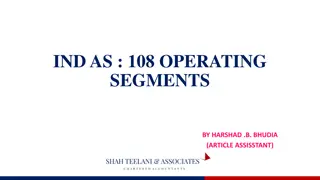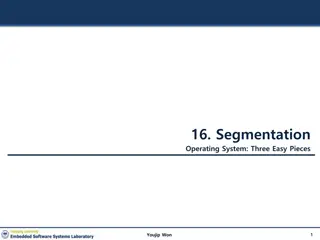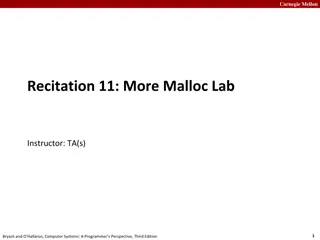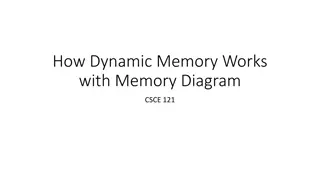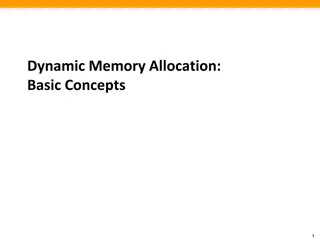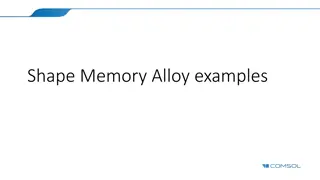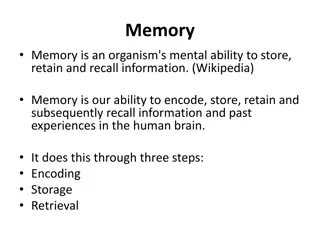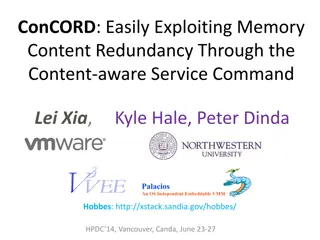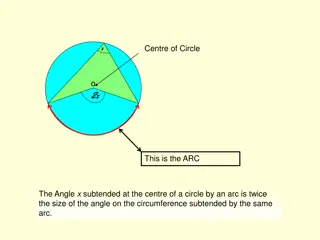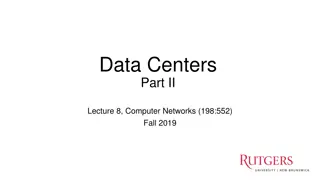Understanding Memory Segments in Computing
Exploring memory segments in Von Neumann architecture, this content delves into the code segment, data segment, stack, and heap segment. It covers their functions, structures, and importance in program execution. The differences, uses, and best practices for each segment are highlighted to enhance understanding of memory management in computing.
Download Presentation

Please find below an Image/Link to download the presentation.
The content on the website is provided AS IS for your information and personal use only. It may not be sold, licensed, or shared on other websites without obtaining consent from the author. Download presentation by click this link. If you encounter any issues during the download, it is possible that the publisher has removed the file from their server.
E N D
Presentation Transcript
CIS 607: _ _ _ _ ______ _ _____ / / / /___ (_) __ ____ _____ ____/ / / ____/ _/_/ ____/__ __ / / / / __ \/ / |/_/ / __ `/ __ \/ __ / / / _/_// / __/ /___/ /_ / /_/ / / / / /> < / /_/ / / / / /_/ / / /____/_/ / /__/_ __/_ __/ \____/_/ /_/_/_/|_| \__,_/_/ /_/\__,_/ \____/_/ \____//_/ /_/ Lectures 9: More on Memory Hank Childs, University of Oregon Nov 22, 2021
Projects Hopefully you are done with 3E (3F?) Timeline for rest of term: 3C: 11/15 3D (optional): 11/15 3E: 11/22 (a thinker, not much code) 3F: 11/22 or 11/29 3G: 11/29 3H+4B: 12/8 Weds Dec 8 @ 10am: Hank does live code of project 3
Operator Precedence Source: http://en.cppreference.com/w/c/language/operator_precedence
Memory Segments Von Neumann architecture: one memory space, for both instructions and data so break memory into segments creates boundaries to prevent confusion 4 segments: Code segment Data segment Stack segment Heap segment
Code Segment Contains assembly code instructions Also called text segment This segment is modify-able ... but that is a bad idea Self-modifying code Typically ends in a bad state very quickly
Data Segment Contains data not associated with heap or stack global variables statics (to be discussed later) character strings you have compiled in char *str = hello world\n
Stack: data structure for collection A stack contains things It has only two methods: push and pop Push puts something onto the stack Pop returns the most recently pushed item (and removes that item from the stack) LIFO: last in, first out Imagine a stack of trays. You can place on top (push). Or take one off the top (pop).
Stack Stack: memory set aside as scratch space for program execution When a function has local variables, it uses this memory. When you exit the function, the memory is lost
Stack The stack grows as you enter functions, and shrinks as you exit functions. This can be done on a per variable basis, but the compiler typically does a grouping. Some exceptions (discussed later) Don t have to manage memory: allocated and freed automatically
Heap Heap (data structure): tree-based data structure Heap (memory): area of computer memory that requires explicit management (malloc, free). Memory from the heap is accessible any time, by any function. Contrasts with the stack
Memory Segments Source: http://www.cs.uwm.edu/classes/cs315/Bacon/
Stack vs Heap: Pros and Cons Stack Heap Allocation/Deal location Automatic Explicit
How stack memory is allocated into Stack Memory Segment Code Data Stack Free Heap
How stack memory is allocated into Stack Memory Segment Code Data Stack stack_varC stack_varD Free Heap
How stack memory is allocated into Stack Memory Segment Code Data Stack stack_varC stack_varD stack_varA stack_varB Free Heap
How stack memory is allocated into Stack Memory Segment Code Data Stack stack_varC stack_varD Free Heap
How stack memory is allocated into Stack Memory Segment Code Data Stack stack_varC stack_varD Free Heap
How stack memory is allocated into Stack Memory Segment Code Data Stack stack_varC stack_varD <info for how to get back to main> A (= 3) <Location for RV> Free Heap
How stack memory is allocated into Stack Memory Segment Code Data Stack stack_varC stack_varD <info for how to get back to main> A (= 3) <Location for RV> stack_varA Free Heap
How stack memory is allocated into Stack Memory Segment Code Data Stack stack_varC stack_varD <info for how to get back to main> A (= 3) <Location for RV> stack_varA Return copies into location specified by calling function Free Heap
How stack memory is allocated into Stack Memory Segment Code Data Stack stack_varC = 6 stack_varD = 3 Free Heap
This code is very problematic why? foo and bar are returning addresses that are on the stack they could easily be overwritten (and bar s stack_varD overwrites foo s stack_varC in this program)
Nested Scope Code Data Stack stack_varA Free Heap
Nested Scope Code Data Stack stack_varA stack_varB Free Heap
Nested Scope Code Data Stack stack_varA Free You can create new scope within a function by adding { and } . Heap
Stack vs Heap: Pros and Cons Stack Heap Allocation/Deal location Access Automatic Explicit Fast Slower Memory pages associated with heap may be located anywhere ... may be caching effects Memory pages associated with stack are almost always immediately available
Stack vs Heap: Pros and Cons Stack Heap Allocation/Deal location Access Automatic Explicit Fast Slower Variable scope Limited Unlimited
Variable scope: stack and heap foo is bad code never return memory on the stack from a function bar returned memory from heap The calling function i.e., the function that calls bar must understand this and take responsibility for calling free. If it doesn t, then this is a memory leak .
Memory leaks It is OK that we are using the heap that s what it is there for Code Data Stack The problem is that we lost the references to the first 49 allocations on heap stack_varA The heap s memory manager will not be able to re-claim them we have effectively limited the memory available to the program. Free Heap
Running out of memory (stack) Code Data Stack stack overflow: when the stack runs into the heap. There is no protection for stack overflows. (Checking for it would require coordination with the heap s memory manager on every function calls.) Free Heap
Running out of memory (heap) Code Data Stack Allocation too big not enough free memory If the heap memory manager doesn t have room to make an allocation, then malloc returns NULL . a more graceful error scenario. Free Heap
Stack vs Heap: Pros and Cons Stack Heap Allocation/Deal location Access Automatic Explicit Fast Slower Variable scope Limited Unlimited Fragmentation No Yes
Memory Fragmentation Memory fragmentation: the memory allocated on the heap is spread out of the memory space, rather than being concentrated in a certain address space.
Memory Fragmentation Code Data Stack Free Negative aspects of fragmentation? (1) can t make big allocations (2) losing cache coherency Heap
Fragmentation and Big Allocations Code Even if there is lots of memory available, the memory manager can only accept your request if there is a big enough contiguous chunk. Data Stack Free Heap
Stack vs Heap: Pros and Cons Stack Heap Allocation/Deal location Access Automatic Explicit Fast Slower Variable scope Limited Unlimited Fragmentation No Yes
Memory Errors Array bounds read Array bounds write
Memory Errors Free memory read / free memory write
Memory Errors Freeing unallocated memory Vocabulary: dangling pointer : pointer that points to memory that has already been freed.
Memory Errors Freeing non-heap memory
Memory Errors NULL pointer read / write NULL is never a valid location to read from or write to, and accessing them results in a segmentation fault . remember those memory segments?
Memory Errors Unitialized memory read



















